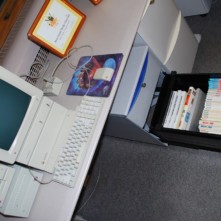Life & Death in the Trauma Center
| June 28th, 2010 12:08 PM by Ken Gagne | Filed under Software showcase; Comments Off on Life & Death in the Trauma Center |
I was searching on YouTube for videos of Apple II games and came across a ten-minute demo of Life & Death. I’d never heard of this game, despite its proliferation in 1988 to Mac OS, DOS, Amiga, Atari ST, and, of course, the Apple IIGS. It appears to be a medical simulation game in which you interact with patients, make diagnoses, then perform surgery. Here’s the video:
On the Apple II, this game is reminiscent of Operation Frog, a game by Tom Snyder (who later went on to create the animated television series Dr. Katz, Professional Therapist). Naturally, there is far less dialogue and diagnosis in Operation Frog, as the game recreates the experience of a high school biology lab and lessons in basic anatomy.
But more striking to me was Life & Death’s resemblance to Trauma Center, a series of video games that launched on the Nintendo DS in 2005 and now enjoys popularity on the Nintendo Wii. In these games, interaction with patients is drawn out into a cohesive storyline. Diagnosis occurs automatically, but you still need to choose the proper tools for surgery; failure to act wisely or swiftly will result in the patient’s death, or game over, returning you to the beginning of the level. Check out the similarities for yourself:
Given the popularity of edutainment software in the 1980s, I’m not surprised that a real-life profession would be simulated in a video game as far back as 22 years ago. What is impressive is that technology has not dramatically changed the nature of electronic entertainment. The interface and complexity of Life & Death and Trauma Center are noticeably different, but the theme and gameplay of the two are almost identical. No one acknowledges the Apple IIGS for pioneering this particular genre, even though it continues to be an unconscious inspiration. For example, it wasn’t until the fifth game in the Trauma Center series, Trauma Team, that players were given the opportunity to diagnose patients themselves.
There’s nothing unusual about Apple II classics inspiring modern hits; I presented on the topic myself at KansasFest 2009 and will be pursuing the issue further at next month’s event. But I never expected Trauma Center, which I previously considered unique to the Nintendo, to have its genesis on the Apple II. It truly was a computer ahead of its time, even recreationally.













